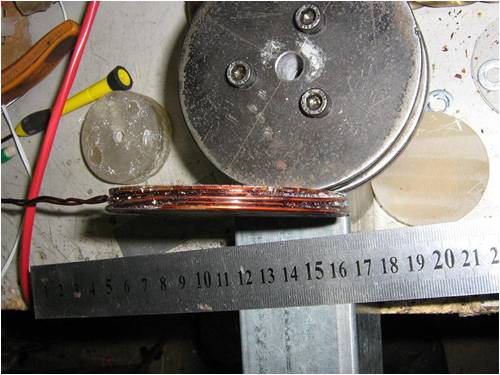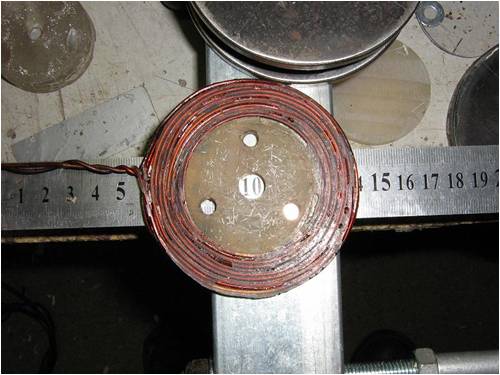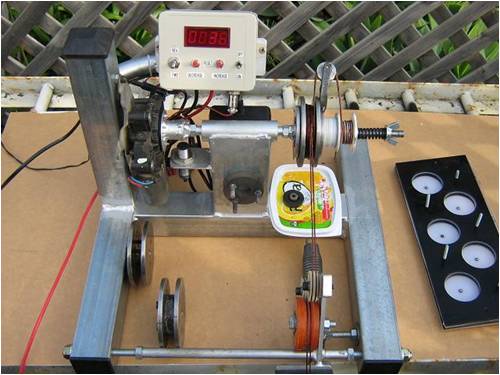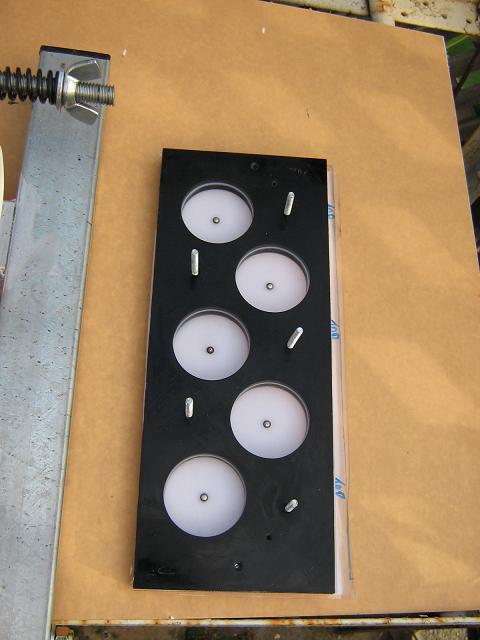
|

|
Forum Index : Windmills : Axial flux setup
| Author | Message | ||||
ProTow Newbie Joined: 03/09/2010 Location: United StatesPosts: 29 |
Ok here is another drawing i did. its on a 12" mag disk x2 and the coil layout. see if this is better. also i see in Hughs book it says to use a 7lbs roll of essex wire would that be enough to do the 9 coils? say 14 or 16 gauge wire 2010-09-10_060909_windgen_mags_12inch.pdf If it works the First time You did something Wrong. |
||||
Downwind Guru Joined: 09/09/2009 Location: AustraliaPosts: 2333 |
Is there any reason why you are using square magnets. Any shape will work, but many on this forum has had better results with round magnets, and there seems to be less stator burnouts with round magnets. It also makes the coils a little easier to wind. Fancy drawings is one thing, but you need to decide on your magnets to get the physical inner coil size (hole) then workout how large your coils will be with the wire turns needed so you can then workout the spacings. Pete. Sometimes it just works |
||||
MacGyver Guru Joined: 12/05/2009 Location: United StatesPosts: 1329 |
Downwind Hi Pete. I was recommending the square ones to him, since I've had so many complications with "cancellation". I think in my case it may have more to do with the physical geometry, being that my magnets are only 1/2" wide and 1/4" thick. A coil wide enough to have enough turns to work, encroaches upon the pass-over space to the next magnet. On the other hand, make it too small and wires of the same coil, but on the opposite leg cancel out what's being made in the first place. With round magnets an inch or larger in diameter, it is likely not a problem, but knowing all the crap I've had to contend with, I recommend square magnets for his build merely on general principle. You're right about round coils being way easier to wind than square ones. For anyone else winding round coils, I've discovered a drop or two of thin CA glue (cyanoacrylate) while the wires are on the winding mandrel makes it not want to fly apart as it's being removed. What I do is add a drop or two of glue and hit it with a spray of "kicker" which makes it go off almost instantly. . . . . . Mac Nothing difficult is ever easy! Perhaps better stated in the words of Morgan Freeman, "Where there is no struggle, there is no progress!" Copeville, Texas |
||||
Downwind Guru Joined: 09/09/2009 Location: AustraliaPosts: 2333 |
Ok i didnt realise this was a toy mill and thought the magnets were around the 2" range. You are better off to use resin on the wire as you wind (a coat per layer)to glue it all together but it makes it slower to wind the coils and a bit slippery, but at least you wont get wire movement within the coils. A quick warm up with the heat gun of the coil after will flash the resin off in a reasonably quick time. Pete. Sometimes it just works |
||||
| VK4AYQ Guru Joined: 02/12/2009 Location: AustraliaPosts: 2539 |
Hi Pete Just a thought on your earlier comment of the coil being more inclined to overheat with square magnets, thinking about it there are two reasons that a coil will overheat, 1 a bad winding job that as you said can cause a loose turn in the coil to short out and burn and 2 the energy transferred to the coils is to much for the wire to carry and the the whole coil overheats. Assuming that the coils are made well and the whole lot of the coils overheat with square magnets as compared to round magnets, to me that is indicating a greater energy transfer to the coils, possibly by the square sides of the magnet coming into play all at once whereas the round magnet tends to sneak up on the windings a bit as it presents a ever increasing section to the coil as it passes. The solution to the coil heating may be more copper to carry more amps. What do you think All the best Bob Foolin Around |
||||
Downwind Guru Joined: 09/09/2009 Location: AustraliaPosts: 2333 |
For starters i have no real facts either way other than reading the posts from others over a long time and seeing a patten with stator failures. Your theory could be correct on the way/area of the magnet approach to the coil. This would imply 2 things, firstly the square magnets are a lot more aggresive to actions within the windings, and i would then expect a greater output. The greater output dont seem to be evident as the Aussie guys using round magnets are punching higher figures then the US boys using square/bar magnets. Secondly the copper content has its own restrictions with resistance, so greater copper content = lower resistance and higher amps. I honestly think it has a lot more to do with the way the coils are constructed dry, and the violent nature of the magnets interacting with the windings. A friend of mine rebuilds motorbike electrical systems and he found out early that rewound coils not fully impregnated with resin fail due to the cycles of energy vibrating the wire within the coils. He has for many years wound the coils dry and then impregnates them with high temp resin in a vacuum chamber and bakes them in and oven to follow, with an almost zero failure rate. Its the same effects taking place in a mill stator and we should pay attention to lessons learnt in other industries. Its harder and messier to wind a coil wet but it is well worth the end results. The heavier the wire the greater the air space within the coil so the greater the movement. Most large transformer coils in heavy wire are potted or have a seperating layer wound between the layers for this very reason. I see it as bad practices in making coils have been adopted and are followed by the unaware DIY makers. You can wind a coil dry then place it in a tin of resin and the tin and coil in a plastic bag and suck all the air out with a vacuum cleaner, then remove the coil and hang it to dry, Its not a perfect method as the vacuum should be down to minus 15 psi or greater but is a lot better than casting dry coils into the stator. I use an old compressor out of a fridge to vacuum bag fiberglass down the minus 15 psi with very good results. Just beware at minus 15 psi the vacuum will crush a tin can inside a plastic bag. I found that out the hard way 
Pete. Sometimes it just works |
||||
MacGyver Guru Joined: 12/05/2009 Location: United StatesPosts: 1329 |
VK4AYQ Another thing that might come into play occurs when folks are charging batteries with wind turbines. The battery "clamps" the voltage at whatever it is rated at and if the turbine spins up way fast, the increase in voltage tends to heat up the stator. With added heat, it may increase the chances of a coil failure. Just thought I'd throw this into the discussion. . . . . . Mac Nothing difficult is ever easy! Perhaps better stated in the words of Morgan Freeman, "Where there is no struggle, there is no progress!" Copeville, Texas |
||||
| VK4AYQ Guru Joined: 02/12/2009 Location: AustraliaPosts: 2539 |
Hi Mack That's right as the voltage is clamped to the battery voltage the more torque applied to the generator as a quotient of the power the amps will rise to reflect the power absorbed by the turbine. This leads to the thought of letting the volts rise as well, and using a MPPT type switching down converter to maintain safe amps in the windings while letting the power increase as in, EG: 30 volts X30 amps = 900 watts and a 100 volts times 30 amps = 3000 watts with the same winding amps. Food for thought as it is the current carrying capacity of the windings that's easily exceeded when using small wire to get more turns. All the best Bob Foolin Around |
||||
| Tinker Guru Joined: 07/11/2007 Location: AustraliaPosts: 1904 |
Pete, I dont agree with your comment above. Thicker wire will have a *proportional* similar air space between the windings than thinner wire has. Also, thicker wire is much stiffer, suggesting *proportionally* less movement. Also, agree that a vacuum of minus 15 PSI (as you put it) is desirable but you might have to find another planet to get a greater one. Hint, check the pressure a column of air of 1 sq inch exerts at sea level on earth. Lastly, your comment of "wet coil winding" has me puzzled. It suggests you impregnate the wire *before* you wind it onto the coil former. Surely not! It would indeed be a messy job. Most people do the impregnating afterwards. Tinker Klaus |
||||
ProTow Newbie Joined: 03/09/2010 Location: United StatesPosts: 29 |
ok after reading I think i better do somemore research on the different mags. If im going to do this I want to do it right the First time. So back to more research and Reading UGH lol... and i love all the input it does help If it works the First time You did something Wrong. |
||||
Downwind Guru Joined: 09/09/2009 Location: AustraliaPosts: 2333 |
Hi Tinker, Yes the air gap within the coil is proportional to wire size, but the bigger the wire the less turns per layer, and the harder it is to keep the coil fully packed on each layer of the windings. This allows more room for movement. The stiffness of the wire has little to do with it when subjected to the mass forces of the magnets. Winding a wet coil, i thought would have been rather obvious that you would be an idiot to attempt to impregnate the wire before winding. 
It simply means to apply a coat of resin to each layer of wire as the layer is wound onto the former. Surely you could have worked that much out??? And from what i have seen very few impregnates a coil, they just cast it into the stator, this is not the same effect. As for being picky with below 1 atmosphere then remove the "or below" from the above comment. The reason for the post is to explain why some coils fail and actions to take to help prevent this, not being politically correct in the post was just for you to have something to comment on. Pete. Sometimes it just works |
||||
| Tinker Guru Joined: 07/11/2007 Location: AustraliaPosts: 1904 |
Yes Pete, I am being picky, glad you noticed 
And no, it was not obvious from your comment that you meant to wet out each *layer* before winding the next one. I certainly would NOT do it that way, way too messy and, depending on the curing time of the resin, the result may or may not be worthwhile. If its a thin epoxy resin with a long curing time (> 30min) then pouring it into a former holding the coil assembly, which have been pre warmed, the penetration is, IME, pretty good. Any air bubbles find their way to the surface before the resin starts going off. Motor winders do pre heat the wound stator/ rotor, then impregnate the windings with resin (usually by brush) and cure the lot in an oven. Its a time proven method and I think I will contact the local shop to see if this resin can be got in one liter tins. I do have an old oven in the shed that would do nicely for the curing process. Of course, this method does not create a coil mould, just the windings are sealed together very firmly. It would then be simple to place the sealed coils into the mould and make a stator plate for an AXFX. For the best results the vacuum moulding technique is best. I would do that by using the vacuum to suck the resin into the mould from holes at the underside and clamp the hoses as the resin starts entering the vacuum hose(s). It takes a fair bit of setting up though. Klaus Klaus |
||||
Downwind Guru Joined: 09/09/2009 Location: AustraliaPosts: 2333 |
As for vacuum impregnation it is far easier than you think. I used an old water filter and placed the tin of resin inside the filter chamber with the coil sitting in the resin then vacuumed the whole chamber down for a minute or two, then removed tin and coil, replace the coil with another and repeat the process. You can do 9 coils in less time than it takes for the resin to gel. It will give 100% saturation this way but dunking them in a resin bath will give 20% saturation at the best. The advantage with winding a wet coil is you can get a perfect square coil and not rounded like a dry wound coil removed from the former. I have 3 coil formers so i do 3 wet coils at a time before removing them from the former when cured. Its a bit slower but the results are worth the extra effort. Pete. Sometimes it just works |
||||
MacGyver Guru Joined: 12/05/2009 Location: United StatesPosts: 1329 |
Pete Please favor us with a picture or two! 
. . . . . Mac Nothing difficult is ever easy! Perhaps better stated in the words of Morgan Freeman, "Where there is no struggle, there is no progress!" Copeville, Texas |
||||
| Greenbelt Guru Joined: 11/01/2009 Location: United StatesPosts: 566 |
Time has proven that I am blind to the Obvious, some of the above may be True? |
||||
| Gizmo Admin Group Joined: 05/06/2004 Location: AustraliaPosts: 5078 |
I agree the coils need to be impregnated. The coils and magnets are pushing against eachother with great force when a windmill is under load. Each loop of copper wire wants to move out of the magnet path, its been squeezed, pushed and pulled a dozen times or more for each revolution of the turbine. If its loose, it will rub against the other loops of wire, eventually wearing down the enamel and causing internal shorts, a over heating coil and eventual failure. Thats why we see photos of cooked stators with only one burnt coil, where you would expect to see all coils burnt if it was overloaded. By impregnating the coils, we lock them in place and they become a structual part of the stator. The same with the magnets, its not centrifugal force that causes them to slip of the magnet plates, they are been pushed out by the coils, in the same way the coils are pushed by the magnets. Its the old "every action has a equal and opposite reaction" rule. That is why the magnets must be glued, pined or screwed to the plates. Painting a layer of epoxy on each coil layer as its wound is a easy way to ensure the individual loops of wire cant move against eachother. It does mean the coils need to stay in the coil winder while the epoxy cures though. Pete's done some tests with vacuume impregnation and I've see some pics of this early attempts, I think if you have access to a vac pump it could be one way to go, air bubbles inside a coil serve no useful purpose. Glenn The best time to plant a tree was twenty years ago, the second best time is right now. JAQ |
||||
Downwind Guru Joined: 09/09/2009 Location: AustraliaPosts: 2333 |
Here is a "wet wound" sample coil. It is wound with 1.6mm wire (#14) from a burnt out transformer so it is not a useable coil but just done as a test wind. It is also only half thickness, as was playing with the idea of stacking 2 coils rather than winding 2 in hand. It is also wound so both wire ends are on the outside and not 1 in and 1 out as most would wind it. 

I cast a resin core and wind the coil onto it and the core can stay in the finished coil, this will make placement of the coils easier and the centre of the coil would get filled with resin in the stator, so may as make that section in the coil to start with. Pete. Sometimes it just works |
||||
Downwind Guru Joined: 09/09/2009 Location: AustraliaPosts: 2333 |
Here is the coil winder. The motor was only used because i was too lazy to build a brake system to hold tension on the coil when the winding was stopped. A worm drive motor lying around seemed an easy option. Yes it dose use a Picaxe to control the winding speed, and as a picaxe was used though may as well add a turns counter........it grew??? The speed is controlled from a old set of pedals from a computer game i picked up at the dump for $1.00. 
Heres the mold for the coil cores. 
All very simple. Pete. Sometimes it just works |
||||
MacGyver Guru Joined: 12/05/2009 Location: United StatesPosts: 1329 |
Pete Thanks for the pictures. Very nice work. 
. . . . . Mac Nothing difficult is ever easy! Perhaps better stated in the words of Morgan Freeman, "Where there is no struggle, there is no progress!" Copeville, Texas |
||||
| VK4AYQ Guru Joined: 02/12/2009 Location: AustraliaPosts: 2539 |
Hi Pete Nice bit of gear it certainly is more efficient than running the lathe to wind a little coil, I think I will make one with an old windscreen wiper motor as I have a spare one in the junk box {shed}it is a two speed one so should work OK. All the best Bob Foolin Around |
||||